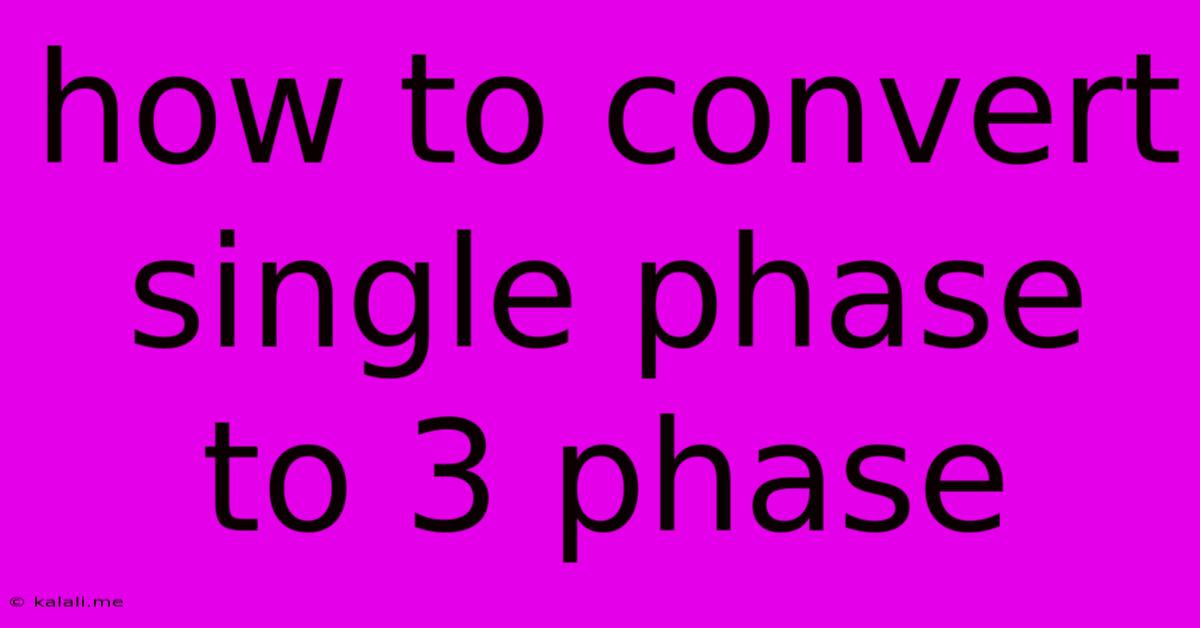How To Convert Single Phase To 3 Phase
Kalali
May 23, 2025 · 3 min read

Table of Contents
How to Convert Single-Phase Power to Three-Phase Power: A Comprehensive Guide
Meta Description: Learn how to convert single-phase power to three-phase, exploring various methods including phase converters, rotary converters, and static converters, weighing their pros and cons for different applications. This guide provides a detailed overview of the process and considerations.
Many industrial applications and certain power tools require three-phase power for optimal performance. However, single-phase power is more commonly available in residential and some commercial settings. This article explores various methods for converting single-phase power to three-phase, helping you choose the best solution for your specific needs. The choice depends on factors like power requirements, budget, and the complexity of the installation.
Understanding the Difference: Single-Phase vs. Three-Phase Power
Before diving into conversion methods, it's crucial to understand the fundamental difference. Single-phase power supplies power through two wires (hot and neutral), resulting in a single alternating current (AC) waveform. Three-phase power, on the other hand, uses three hot wires and a neutral (in some configurations), providing three AC waveforms offset by 120 degrees, offering significant advantages in power delivery and motor efficiency.
Methods for Single-Phase to Three-Phase Conversion
Several methods exist for achieving this conversion, each with its own advantages and disadvantages:
1. Phase Converters: These devices are the most common solution for converting single-phase power to three-phase. They come in two primary types:
-
Rotary Phase Converters: These are electromechanical devices that use a motor-generator set to create a three-phase output from a single-phase input. They are generally more efficient, particularly for high-power applications, and can handle higher starting currents for larger motors. However, they are larger, more expensive, and require more maintenance than static converters. Key Considerations: Motor starting torque, power factor correction capabilities, and overall efficiency.
-
Static Phase Converters: These use electronic components (like capacitors and other circuitry) to create a three-phase output. They are typically smaller, quieter, and cheaper than rotary converters. However, they are generally less efficient, especially under heavy loads, and may not be suitable for all motor types. Key Considerations: Power rating, harmonic distortion, and compatibility with specific motor loads.
2. Three-Phase Motor Starters:
Some motor starters are designed to operate a three-phase motor from a single-phase power supply. While not strictly a converter, this method is a viable option for starting certain three-phase motors from a single-phase source.
3. Using Multiple Single-Phase Motors:
For less demanding applications, employing multiple single-phase motors can sometimes replace the function of a single three-phase motor. However, this approach is less efficient and may not be suitable for all situations.
Choosing the Right Conversion Method
The optimal method depends on various factors:
-
Power Requirements: The amount of power needed significantly influences the type of converter required. High-power applications often demand rotary converters for their efficiency, while lower-power applications might be sufficiently served by static converters.
-
Budget: Rotary phase converters are generally more expensive than static converters.
-
Motor Type and Load: Certain motor types are more compatible with specific converters. Consider the type of three-phase motor you'll be running and its starting characteristics.
-
Maintenance: Rotary converters require regular maintenance, whereas static converters generally require less attention.
-
Harmonics: Static converters can introduce harmonic distortion into the power system, which may need mitigation in sensitive applications.
Safety Precautions
Working with electricity is inherently risky. Always consult with a qualified electrician before attempting any single-phase to three-phase conversion. Improper installation can lead to electrical hazards, equipment damage, and potentially serious injury. Ensure all work adheres to local electrical codes and safety regulations.
Conclusion
Converting single-phase power to three-phase provides access to the benefits of three-phase power for various applications. By carefully considering the power requirements, budget constraints, and technical aspects, you can choose the most appropriate conversion method and ensure a safe and effective installation. Remember, prioritizing safety and professional assistance is paramount.
Latest Posts
Latest Posts
-
How To Move A Stacked Washer Dryer
May 23, 2025
-
Can We Catch Governet Limit Exceotion In Try Catch
May 23, 2025
-
Both Of You Are Doing Well
May 23, 2025
-
What Is A Group Of Dragonflies Called
May 23, 2025
-
How To Add Oil To Ac Compressor Without Vacuum
May 23, 2025
Related Post
Thank you for visiting our website which covers about How To Convert Single Phase To 3 Phase . We hope the information provided has been useful to you. Feel free to contact us if you have any questions or need further assistance. See you next time and don't miss to bookmark.